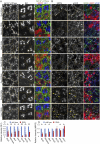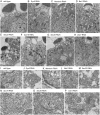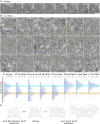Golgi clustering by the deficiency of COPI-SNARE in Drosophila photoreceptors
- PMID: 39296936
- PMCID: PMC11408282
- DOI: 10.3389/fcell.2024.1442198
Golgi clustering by the deficiency of COPI-SNARE in Drosophila photoreceptors
Abstract
A comprehensive study of soluble N-ethylmaleimide-sensitive factor attachment protein receptors (SNAREs) in the fly genome by RNAi in Drosophila photoreceptors indicated that knockdown of any of the COPI-SNAREs, Syx18, Sec20, and Use1, resulted in the same characteristic phenotypes: Golgi stacks gathering on their trans-side, laterally expanded Golgi cisternae, and a reduced number of discrete Golgi stacks. These Golgi stacks are reminiscent of mammalian Golgi ribbons and Brefeldin A (BFA)-bodies in Drosophila S2 cells. As previously reported, BFA suppresses trans-Golgi network (TGN) fission and Golgi stack separation to form a BFA-body, which is a cluster of Golgi stacks cored by recycling endosomes. We found that the impairing each of COPI-SNAREs results in clustered Golgi stacks similar to BFA-bodies, indicating that COPI-SNAREs have a role to separate clustered Golgi stacks. These results further support the idea that the movement of Golgi stacks and the balance of fusion and fission of the TGN determine the level of clustering and ribbon formation of Golgi stacks within cells.
Keywords: BFA-body; Drosophila; Golgi stacks; photoreceptors; recycling endosomes.
Copyright © 2024 Tago, Yamada, Goto, Toyooka, Ochi, Satoh and Satoh.
Conflict of interest statement
The authors declare that the research was conducted in the absence of any commercial or financial relationships that could be construed as a potential conflict of interest.
Figures




Similar articles
-
Sec71 separates Golgi stacks in Drosophila S2 cells.J Cell Sci. 2020 Dec 29;133(24):jcs245571. doi: 10.1242/jcs.245571. J Cell Sci. 2020. PMID: 33262309 Free PMC article.
-
Reevaluation of the effects of brefeldin A on plant cells using tobacco Bright Yellow 2 cells expressing Golgi-targeted green fluorescent protein and COPI antisera.Plant Cell. 2002 Jan;14(1):237-61. doi: 10.1105/tpc.010237. Plant Cell. 2002. PMID: 11826310 Free PMC article.
-
Brefeldin A action and recovery in Chlamydomonas are rapid and involve fusion and fission of Golgi cisternae.Plant Biol (Stuttg). 2007 Jul;9(4):489-501. doi: 10.1055/s-2006-924759. Epub 2007 Feb 15. Plant Biol (Stuttg). 2007. PMID: 17301935
-
SNAREs and membrane fusion in the Golgi apparatus.Biochim Biophys Acta. 1998 Aug 14;1404(1-2):9-31. doi: 10.1016/s0167-4889(98)00044-5. Biochim Biophys Acta. 1998. PMID: 9714710 Review.
-
Formation of Tubulovesicular Carriers from Endosomes and Their Fusion to the trans-Golgi Network.Int Rev Cell Mol Biol. 2015;318:159-202. doi: 10.1016/bs.ircmb.2015.05.005. Epub 2015 Jul 8. Int Rev Cell Mol Biol. 2015. PMID: 26315886 Review.
Cited by
-
Comprehensive study of SNAREs involved in the post-Golgi transport in Drosophila photoreceptors.Front Cell Dev Biol. 2024 Dec 10;12:1442192. doi: 10.3389/fcell.2024.1442192. eCollection 2024. Front Cell Dev Biol. 2024. PMID: 39720007 Free PMC article.
References
LinkOut - more resources
Full Text Sources
Molecular Biology Databases
Research Materials
Miscellaneous

